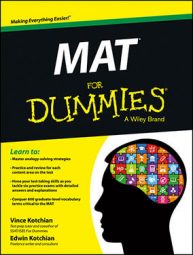To build your social science analogy muscles, make sure you’re familiar with the main people, terms, and events in economics. For the MAT, it helps to know first that economics deals with the study of how people provide goods and services to one another.
Here you’ll find the basic economics terms you need to know, along with some key economics figures, to give you a working knowledge of what the MAT may test.
Economics terms that appear on the MAT test
Brush up on your knowledge of economics by studying these terms and their definitions.
Bankruptcy: The legal status of a debtor who cannot pay his debts
Capitalism: Private ownership–based economic system
Communism: Economic system in which the people control the means of production
Consumer Price Index (CPI): Measure of changes in the prices of consumer goods
Credit: Acquiring a good or service and paying for it later
Debt: Money owed
Depression: A severe, long-term recession
Expansion: Period of increased economic activity
Federal Deposit Insurance Corporation (FDIC): Guarantees the security of deposits in banks
Federal Reserve Board of Governors: Group that oversees the central banking system of the United States
Federal Trade Commission (FTC): Protects consumers by opposing anticompetitive business methods
Gift economy: A culture in which goods are given without an agreement for reciprocation
Gross National Product (GNP): Value of products and services produced by a country in a year
Heterodox economics: Economic schools of thought that are not mainstream
Inflation: The rise of prices over time
Interest: A fee paid to borrow money, expressed as a percentage of the money borrowed
Labor union: Group of workers united to achieve common goals that would better their conditions of employment, known as a “trade union” in British English
Market: System in which parties exchange with each other
Mass production: Creating great amounts of products on assembly lines
Monopoly: A single entity is the only supplier of a specific good or service
Protectionism: Government regulating trade between countries to promote domestic trade
Recession: Period of a slowdown of economic activity
Socialism: Social ownership–based political system
Old-Age, Survivors, and Disability Insurance (OASDI): Federal program. The original Social Security Act (1935) and the current version of the act, as amended, encompass several social welfare and social insurance programs
Subsidy: Money paid by a government to a business or industry to help it or to encourage specific behavior
Supply and demand: Model for determining prices of goods in a competitive market
Important figures in the field of economics
The following lists important people in the field of economics that you should know before taking the MAT.
Friedman, Milton: American economist who won the Nobel Prize
Greenspan, Alan: American economist who served as Chairman of the Federal Reserve
Keynes, John Maynard: British economist who contributed to modern macroeconomics
Krugman, Paul: American economist who won the Nobel Memorial Prize
Malthus, Thomas: English political economist who theorized about population growth and decline
Marx, Karl: German economist who first created the principles of communism
Smith, Adam: Scottish economist who wrote The Wealth of Nations

